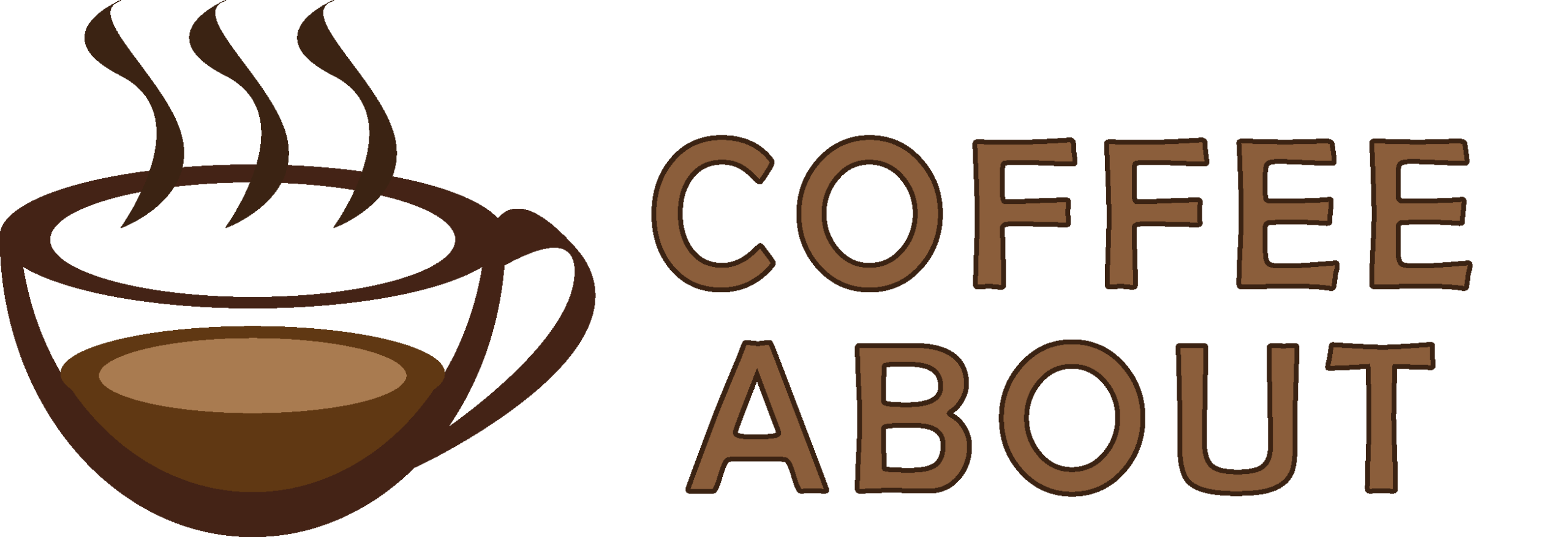Both Latte and Macchiato start with espresso as a base, but they differ in their milk content. The Macchiato is a small drink around 3 oz prepared with just a splash of milk, and has bold coffee-forward flavors. The Latte is around 8-12 oz and prepared with a large amount of milk, which makes it smooth and creamy.
If you’re all about those rich espresso notes, the macchiato’s your drink. But if you prefer something smoother and creamier, you can’t go wrong with a classic latte.
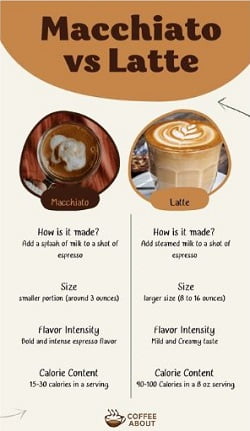
what is Espresso Macchiato?
Espresso macchiato is made by adding a small amount of milk foam over an Espresso shot.
A macchiato in Italian means “stained” or “marked”, referring to how a dollop of milk is added to espresso, leaving an impression of white milk on the dark color of Espresso.
Macchiato is a small drink around 2-3 oz and is characterized as a bolder and more intense coffee experience compared to other milk-based espresso drinks.
At a coffee shop, they usually serve a single shot of espresso with a splash of foamed milk in a demitasse cup.
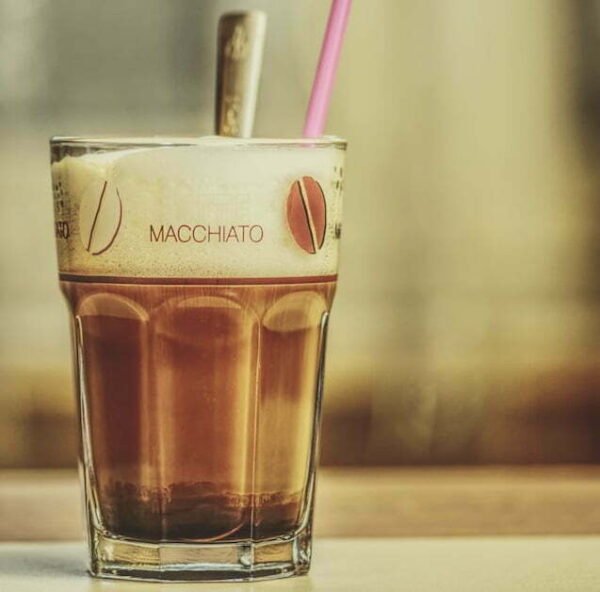
How to make Espresso Macchiato
Making a delightful Italian macchiato involves finding the perfect milk-to-espresso ratio. Too much milk and you’ll venture into cappuccino or latte territory.
The goal is to strike a balance, adding enough milk to bring a touch of creamy sweetness without overpowering the bold espresso flavor.
- Start by preparing a single or double shot of espresso using finely ground dark-roasted coffee.
- Next, heat an ounce of milk to around 160 degrees Fahrenheit and create foam using a steam wand.
- Finally, top the Espresso shot with foamed milk.
What is a Latte?
Latte is a famous milky coffee drink prepared with one or two shots of Espresso a lot of steamed milk and thin a layer of milk foam on top. Typically, in a latte, the ratio of espresso to milk is 1:3 or 1:4.
Unlike the macchiato, the latte is a milder and more milk-centric coffee beverage. The term “latte” comes from the Italian word “caffè latte”, which means “milk coffee.”
The large proportion of steamed milk mellows the intensity of the espresso, creating a sweet and creamy flavor profile.
Latte is believed to have originated in European coffeehouses in the 17th century and has since become a staple in coffee culture worldwide.
The latte’s widespread popularity can be attributed to its versatility. By adding flavored syrups such as vanilla, chocolate, or caramel, diverse latte variations have emerged, catering to those who relish a touch of sweetness in their coffee.
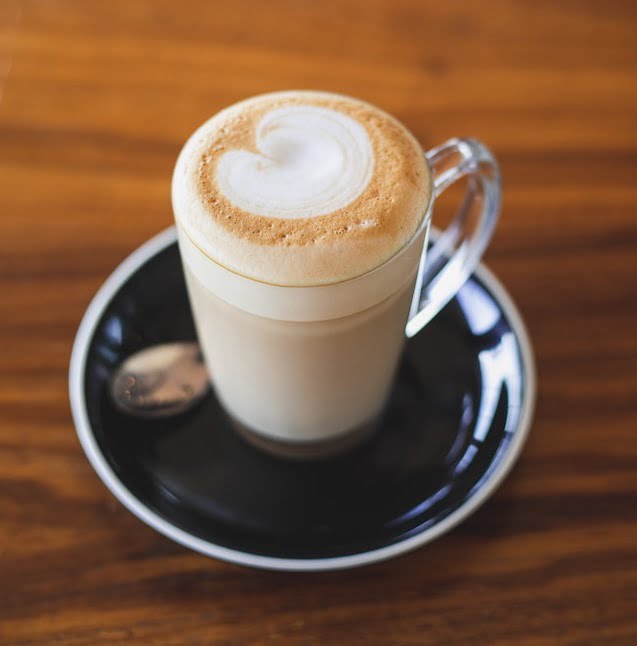
Is Latte Macchiato the Same as Macchiato?
While the names may sound similar, a latte macchiato is not the same as a macchiato!
A latte macchiato is a different beast altogether. It’s basically a Starbucks invention.
The Latte Macchiato is almost the same as Cafe Latte with a slight variation in the preparation method.
While preparing latte macchiato, the Espresso is layered at the last on top of steamed milk giving the drink a bold first sip.
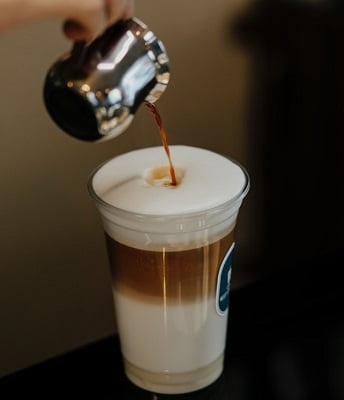
Macchiato means stained in Italian, as we discussed above. So, In Espresso Macchiato, the espresso is stained with a small amount of milk, while in Latte Macchiato, the Latte (milk in Italian) is stained with a small amount of espresso.
So, In short, you can say that Latte Macchiato is nothing but an upsidedown version of a traditional Latte
In an effort to provide clarity and help customers understand the distinctions between their diverse espresso drinks, Starbucks released this infographic:

How the type and Amount of Milk Differs?
In Espresso macchiato, the milk-to-coffee ratio is 1:2, with one part milk and two parts espresso. On the other hand, a caffè latte has a ratio of 3:1, with three parts milk and one part Espresso.
Traditionally, both lattes and macchiatos are made with whole milk.
However, there are many variations of Latte, allowing for the use of different types such as skim milk, half and half, or nondairy milk alternatives like almond, soy, or oat milk.

The Difference in Taste and Flavor Profiles
Macchiatos have a stronger Espresso-forward taste compared to Lattes, as it is prepared with just a splash of frothed milk. Macchiato is typically enjoyed without sugars or flavorings.
Whenever I am in need of a caffeine boost on busy afternoons, I love to drink Espresso Macchiato with just a splash of milk.
In contrast, lattes provide a more versatile experience, as they can be infused with various flavors such as cocoa, vanilla, or caramel, allowing for a broader range of taste options.
Lattes are prepared with a large proportion of milk, creating a smooth and creamy texture.
Which has more caffeine and Calories?
Both macchiatos and lattes are made with a single or double shot of espresso, so the caffeine content in both drinks is the same. A standard 1-ounce (30-ml) shot of espresso contains around 63 mg of caffeine and the double shot has 120-130 mg of caffeine.
As expected, Lattes have more calories than Macchiatos as they are prepared with a large quantity of milk.
A simple 8 oz serving of Latte without any sugar or additives has around 90 to 100 calories. While the Macchiato has only 15-20 calories
The macchiato has very few calories so it is considered healthier than Latte. However, Latte is also a very healthy drink when drunk in moderation.
How Are These Drinks Different from Cappuccino?
Cappuccino, Latte, and Macchiato are all popular milk-based Espresso drinks with only a slight difference in preparation method and ratios of ingredients.
A cappuccino consists of equal parts steamed milk, espresso, and milk foam. While Latte has a large proportion of Milk and the Macchiato has only a splash of milk.
This table highlights the key differences between cappuccino, latte, and macchiato:
| Coffee Drink | Ingredients | Proportions | Topping |
| Cappuccino | Espresso, Steamed Milk, Foam | Equal parts of each | A thick layer of foam |
| Latte | Espresso, Steamed Milk, Foam, Sugar or Syrups (Optional) | More steamed milk than espresso | A thin layer of microform and optional flavorings |
| Macchiato | Espresso, Steamed Milk, Foam | Splash of Milk | A thick layer of foam |
Macchiato vs Latte: So What’s Better?
If you’re craving a creamy experience, the latte takes the spotlight. Its generous milk content offers a velvety texture, and the option to add flavors like Vanilla, or Chocolate improves its allure.
On the other hand, if you prefer a bold espresso-forward profile with a subtle milky flavor, the macchiato is the winner. Its intense flavor lets the nuances of the espresso shine through, with just a touch of milk for balance.
Personally, I appreciate the depth and intense flavors of a well-crafted macchiato when I’m in the mood for a strong coffee experience.
Comment with your favorite drink, Macchiato or Latte!
Also read:
FAQs
What is a latte with less milk called?
A latte with less milk is often referred to as a “flat white.” It contains a higher ratio of espresso compared to a traditional latte, resulting in a stronger coffee flavor.
What macchiatos does Starbucks have?
Starbucks serves four hot Macchiato drinks. The Latte Macchiato, Caramel Macchiato, Apple Crisp Macchiato, and the traditional Espresso Macchiato.
